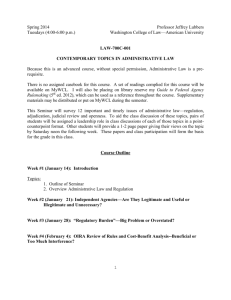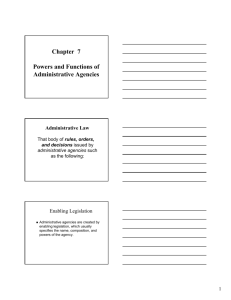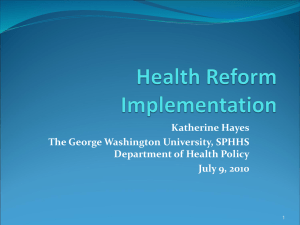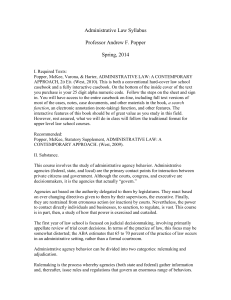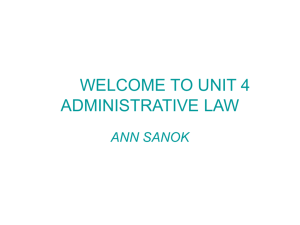Administrative Law Prof. Kumar, Fall 2016 Email:
advertisement
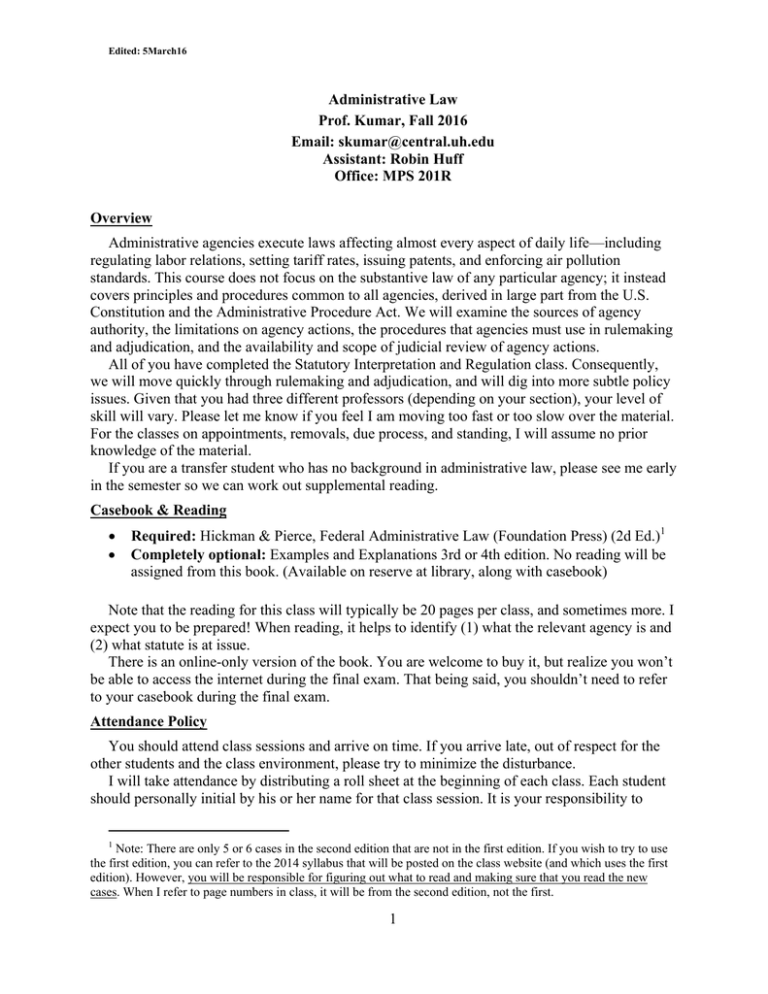
Edited: 5March16 Administrative Law Prof. Kumar, Fall 2016 Email: skumar@central.uh.edu Assistant: Robin Huff Office: MPS 201R Overview Administrative agencies execute laws affecting almost every aspect of daily life—including regulating labor relations, setting tariff rates, issuing patents, and enforcing air pollution standards. This course does not focus on the substantive law of any particular agency; it instead covers principles and procedures common to all agencies, derived in large part from the U.S. Constitution and the Administrative Procedure Act. We will examine the sources of agency authority, the limitations on agency actions, the procedures that agencies must use in rulemaking and adjudication, and the availability and scope of judicial review of agency actions. All of you have completed the Statutory Interpretation and Regulation class. Consequently, we will move quickly through rulemaking and adjudication, and will dig into more subtle policy issues. Given that you had three different professors (depending on your section), your level of skill will vary. Please let me know if you feel I am moving too fast or too slow over the material. For the classes on appointments, removals, due process, and standing, I will assume no prior knowledge of the material. If you are a transfer student who has no background in administrative law, please see me early in the semester so we can work out supplemental reading. Casebook & Reading Required: Hickman & Pierce, Federal Administrative Law (Foundation Press) (2d Ed.)1 Completely optional: Examples and Explanations 3rd or 4th edition. No reading will be assigned from this book. (Available on reserve at library, along with casebook) Note that the reading for this class will typically be 20 pages per class, and sometimes more. I expect you to be prepared! When reading, it helps to identify (1) what the relevant agency is and (2) what statute is at issue. There is an online-only version of the book. You are welcome to buy it, but realize you won’t be able to access the internet during the final exam. That being said, you shouldn’t need to refer to your casebook during the final exam. Attendance Policy You should attend class sessions and arrive on time. If you arrive late, out of respect for the other students and the class environment, please try to minimize the disturbance. I will take attendance by distributing a roll sheet at the beginning of each class. Each student should personally initial by his or her name for that class session. It is your responsibility to 1 Note: There are only 5 or 6 cases in the second edition that are not in the first edition. If you wish to try to use the first edition, you can refer to the 2014 syllabus that will be posted on the class website (and which uses the first edition). However, you will be responsible for figuring out what to read and making sure that you read the new cases. When I refer to page numbers in class, it will be from the second edition, not the first. 1 Edited: 5March16 insure that you have initialed the roll sheet before you leave the classroom each day. Students who do not sign the role sheet are deemed to have been absent. You may not sign the role sheet if you miss more than 15 minutes of class. Please note that you are responsible for managing your absences from class and ensuring that your total number of absences does not exceed the threshold for the class. An absence is an absence, regardless of the reason, except for those covered by the University and Law Center religious holiday policy. Students who exceed six (6) absences will be reported to the Associate Dean and will be dropped from the class. If you need to miss a single class, you do NOT need to e-mail me and let me know. I encourage you to e-mail a friend to check if there was a handout you missed, or a modification in the reading assignment. Feel free to contact me if more than a week passes without the recorded lecture being uploaded. If you need to miss several classes, please inform me. Participation I will call on students, both to discuss cases and to comment on the issues we are discussing. If you are unable to prepare for a particular class, be sure to indicate so on the Pass Sheet, which will be at the podium. You may pass twice without any negative effect to your final grade. Students with poor class participation will have their final grade dropped by 1/3 of a letter grade. The decision to drop a grade for participation is at my discretion and is non-negotiable. A drop in class participation can result from a combination of unpreparedness, not paying attention in class, and absences (even if you are within the six-absence limit). In exceptional circumstances, a student may go up a 1/3 of a letter grade for making a substantial contribution to the class. Note that volunteering every class does not constitute a substantial contribution—quality, not quantity matters! Class Website There is a class website on Lexis. To enroll, follow the following steps: . Go to www.lexisnexis.com/lawschool and sign in with your custom ID and password . Once on the home page, under “Learning LexisNexis”>“Class Preparation,” select the “Access Web Courses” link. Web Courses will open in a separate page . Click on the red “Courses” tab at the top of the page . Under “Course Catalogue,” Click the “University of Houston” link . Scroll down the list to find “2016 Administrative Law” with Professor Kumar as the instructor . Click the “Enroll” button If you have any questions on accessing the class website, contact our Lexis representative Billy Saqr (billy.saqr@lexisnexis.com). Please access the class website early in the semester. This is where I post old exams (with model answers and my exam memos), recordings of lectures, all handouts, and the like. Do not wait until two weeks before finals. Audio Recordings of Lectures I will record all of the lectures and upload them to the class website. These recordings are for class preparation purposes only, and they are not to be reproduced or redistributed in any manner. Note that recordings sometimes fail or are lost before they can be uploaded. Having lectures recorded is a privilege. If there is ever a class where more than 20% of the class is absent (excluding poor weather), the lecture will not be recorded. 2 Edited: 5March16 Grading The final exam will be an open book and open notes (i.e., you can bring any printed materials, including commercial outlines). The format will be a mix of multiple choice, short answer, and essay. There will be a word limit on the essay portion of the exam. Office Hours: TBD I encourage everyone to come to office hours, whether to talk about class material, career goals, or anything else. Too often, students who are struggling don’t come to office hours until the end of the semester. Remember—no question is too stupid, unless it is two weeks before the final exam. If you have a question outside of office hours, feel free to e-mail me. Please do not stop by my office outside office hours without e-mailing me first to check my availability—sometimes I am busy preparing for another class or the like. Miscellaneous Class Policies First Names. I call on students by first names, because it is the only way I’ll ever learn your first name. Socratic Method. I will randomly call on students to discuss cases. To do this, I will shuffle a deck of index cards that you fill out on the first day and select a card. This means if you get called on one class, you can still be called on the following class. Or your card may never come up. Volunteering and Class Participation. Students are always welcome to volunteer to discuss cases. Students can also make comments and ask questions in class. That being said, nobody likes to hear from the same three students for the entire semester, so I will sometimes request to hear from students who haven’t spoken recently. Laptop Use. Use of laptops is permitted, with the caveat that studies indicate students learn more when they handwrite notes. Although I do not prohibit web surfing, if your behavior becomes distracting to other students or to me, you will risk a 1/3 letter grade drop for poor participation. Use of old outlines on exam. You are permitted to use any outline you want on the final exam, and you can bring any print materials with you. However, you need to update your old outline. Citing cases or material that we did not cover will cause your answer to be marked down. 3 Edited: 5March16 Reading All statutory provisions are in the Administrative Procedure Act, Title 5 of the U.S.C. Each class will cover one bullet point worth of material. I. What is Administrative Power? The U.S. Constitution creates and vests three types of power in Articles I, II, and III—the legislative, the executive, and the judicial, respectively. Nowhere does it mention any other kind of power, but neither does it say that this omission is intentionally exclusive. This portion of the course explores the ways in which the three branches of government relate to the administrative departments, agencies, commissions, offices, etc., according to modern doctrine. Constitutionality of Delegating Policymaking Authority. Read entire syllabus, plus p. 23–25, 30–35, 45–53, 60–66. Historically, the Supreme Court has taken a very deferential view of how much lawmaking authority Congress may “delegate” to (or vest in) an administrative agency without violating Article I, as we see in Schecter. Post-Schecter, we see a dramatic drop in use of the non-delegation doctrine. The D.C. Circuit attempts to revive the doctrine in Amercian Trucking Association, only to be reversed by the Supreme Court. Yet, the non-delegation doctrine still lives on, albeit in another form. Focus Questions: (1) What is the non-delegation doctrine and the intelligible principal test? (2) Why is the Supreme Court concerned about the delegation in Schecter? (3) What is left of the non-delegation doctrine after Mistretta and American Trucking Association? (4) What is Scalia’s main concern in Mistretta? (5) How does American Trucking Association modify the non-delegation doctrine and intelligible principal test? Controlling Delegations; Appointment of Agency Officials; Article II. p. 135–144, 157 (bottom of page)–163, read Problem 1. The Chadha case represents a major shift in the law. Congress previously had included its own invented check on administrative agency discretion—better known as legislative veto—in organic acts going back for decades. We then shift to examining who is an officer of the United States under the Constitution’s Appointments Clause. This material may partially overlap with material you covered in Constitutional Law. Focus Questions: (1) Why did the Chadha court find legislative veto unconstitutional? (2) After Chadha, would a two-house legislative veto that can’t take effect without presentment to the President be constitutional? (3) Under A2S2C2 of the Constitution, what type of officers can Congress appoint? What type of officers must be appointed by the President? 4 Edited: 5March16 Agencies and Article II: The President’s Relationship to the Administrative Agency. p. 168–183. Unlike models known to the framers in the late eighteenth century, Article II vests the “executive Power” in one official alone. But as Buckley illustrates, Article II also creates a rather complex array of relationships between the Congress, President, and appointed officials which define their respective authorities. The recent case law on Article II’s Appointments Clause has been rather ambiguous. Focus Questions: (1) Who is an officer of the U.S.? (2) How do we distinguish between principal versus inferior officers? (3) Can Congress circumvent the appointments clause by altering the duties of existing officers? (4) How do we distinguish between inferior officers and mere employees? Which category do administrative law judges fall into? Removal of Agency Officials. p. 183–193, 222–226, skim 228–246, Problem 2. Article 1, Section 5 of the Constitution tells us how to remove members of Congress. But the Constitution does not tell us how to remove executive officers, leading to confusion. Focus Questions: (1) Can Congress specify conditions that must be met before an Officer of the United States can be removed? (2) Can Congress reserve the right to remove an officer charged with execution of the law? II. Due Process Due process is the chief source of procedural controls on agencies outside of those established by statute. Procedural due process doctrine has been relatively stable since a reinvention of the field in the 1970s and 1980s. Due Process concerns arise in both state and federal actions. The Role of the Due Process Clause. p. 277–296, Problem 3. Londoner and Bi-Metallic illustrate the distinction between rulemaking and adjudication. This distinction plays a key role in whether an individual has a right to a hearing. Goldberg introduces the right of procedural due process. (1) How does the distinction between legislation and rulemaking affect due process rights in Londoner and Bi-Metallic? (2) How does the Court in Goldberg expand due process rights? The Rise of the Entitlement Theory. p. 297–312. Roth, Sinderman, and Davis provide us with a framework for determining whether an entitlement exists, and if a liberty or property interest has been implicated. Focus Question: What is the framework for determining whether an individual is entitled to due process? What Process is Due? p. 312–332, Problem 4 Eldridge and Loudermill look at how much due process is required and when it is required. 5 Edited: 5March16 Focus Question: (1) When must a due process hearing occur? (2) How does a court determine how much procedure is required? The Limits of Procedural Balancing: National Security. p. 332–343 and excerpt of Holder’s speech on national security (available on class website). III. Adjudication & Rulemaking Adjudication is exercise of judicial power by an administrative agency. There are two forms of adjudication. Formal adjudication is governed by §§ 554–557 of the APA. It involves a trial-like hearing with witness testimony, a written record and a final decision. By contrast, informal adjudication is a poorly defined category covering a wide range of agency actions, and is not governed by the APA. If an agency process does not involve formal adjudication or rulemaking, it often come under the default heading of informal adjudication. Formal adjudication and informal adjudication are subject to different judicial review standards. Introduction to Formal and Informal Adjudication. p. 343–357 & § 554. Skim §§ 556, 557. Dominion Energy introduces formal adjudication. Overton Park introduces informal adjudication, and further reflects a growing skepticism towards agencies, and introduces questions of policy, which we will return to later in the semester. Pension Benefit Guaranty gives us a more straightforward application of the APA to informal adjudication. Focus Questions: (1) What statutory language triggers formal adjudication? (2) What option is available to the court when the record before it is insufficient to decide the case? (3) Can courts require agencies to engage in additional procedure requires for adjudication that are not in the APA. Judicial Review of Formal and Informal Agency Adjudication. p. 385–390, 408–415; download and read Dickenson v. Zurko, 527 U.S. 150 (1999), Problem 5, § 559, § 706. This section introduces the different standards of review for agency decisions. Note that these standards are distinct from those we see when courts review district court decisions. Here, we examine the two different standards of review for adjudication, and attempt to discern the difference between the standards. Focus Questions: (1) What standard of review applies to findings of fact in formal adjudication? (2) What standard of review applies to findings of fact in informal adjudication? (3) What is the difference between the two standards with regard to the record? (4) What is the difference between the two standards with regard to level of deference? (5) To what extend can Congress change the default standard? Introduction to Rulemaking. p.417–419, 427–430, 441–452 [pay close attention to the second paragraph of SEC v. Chenery on p. 371], Problem 6 This section introduces rulemaking, a powerful tool that allows agencies to create rules that can potentially bind the public. It further looks at why agencies might chose rulemaking over adjudication. 6 Edited: 5March16 Focus Questions: (1) What are some of the advantages of rulemaking? (2) What disadvantages does rulemaking cause to individuals? (3) What discretion does an agency have in choosing between rulemaking and adjudication? (4) Is it permissible for agencies to make rules through adjudication? (5) Why can a court not affirm an agency decision on a ground different from what the agency relied upon? The Decline of Formal Rulemaking and the Rise of Notice and Comment. § 553, p. 458–459, skim 460–464, read 465–479. Although agencies can engaged in a trial-like proceeding to pass rules, formal rulemaking is seldom used. Instead, we see agencies engaging in informal notice-and-comment rulemaking, and rulemaking that falls somewhere in between formal and informal. Focus Questions (1) What is formal rulemaking and why is it disfavored? (2) How do we reconcile Vermont Yankee with Overton Park? (3) What is the logical outgrowth test? Public Participation in Rulemaking. p. 479–494, review § 553(b),(c). Although agencies are bound by § 553, they will often play fast and loose with the information they disclose to the public. These cases continue to explore what constitutes a proper notice to the public of the proposed rulemaking Focus Questions (1) What constitutes sufficient notice under the APA? (2) What type of information must the agency disclose to the public prior to the comment period? (3) What constitutes a concise general statement? Highly Informal Rules. p. 523–526, 539–541, 542–560. Much rulemaking is even less formal than notice-and-comment rulemaking. The line between legislative notice-and-comment rules and non-legislative rules (such as interpretive rules and policy statements) is blurry, at best. Yet the distinction is important, as agencies will often try to treat non-legislative rules as binding on the public, in an attempt to circumvent the more rigorous notice and comment process. This is an extremely messy and frustrating area of administrative law—do your best. Focus Questions: (1) What is the difference between substantive rules, interpretive rules, and general statements of policy? (2) How do the standards of review differ for these three types of rules? Questions of Policy & Hard Look Review. p. 560–562, 568–578, review Overton Park. Focus Questions (1) What is hard look review? (2) To what type of questions does hard look review apply? (3) What information will the agency consider when reviewing under hard look review? IV. Statutory Interpretation in Administrative Law Judicial deference to agencies is the heart of this course. The fact that agencies have specialized knowledge that general courts do not differentiate judicial review of agency decisions from 7 Edited: 5March16 judicial review of lower court decisions. Disputes regarding what standard review should apply can sometimes reflect tension between the judicial and executive branches of government. The Chevron Revolution. p. 597–598, 605–608, 613–621 (note: pay close attention to first full paragraph on p. 615), Problem 8. Chevron is one of the most cited and influential decisions in modern Supreme Court history. The Supreme Court did not intend for Chevron to be a major departure from its prior precedent. But the requirement that courts provide strong deference to agencies where Congress merely implicitly delegates interpretive authority is the revolutionary aspect of the case. Focus Questions: (1) Describe the level of deference that the Court affords the agency in Skidmore, (2) What is the Chevron two-step test? (3) What is a question of law versus a question of policy? The “Tools” of Step One Analysis. p. 643–661, 708–709. Chevron originally appeared to be highly deferential to agencies. However, the Supreme Court soon started chipping away at its decision, starting with allowing courts to utilize the traditional tools of statutory interpretation in determining whether a statute is ambiguous. Focus Questions: (1) What tools can courts utilize in a Step One analysis? (2) What are some of the problems with using such tools, with regard to agency autonomy? (3) How does the D.C. Circuit’s approach to Step Two differ from other courts? The Mead Counter-Revolution. p. 718–730, 737–747, Problem 9. Chevron was substantially weakened in subsequent Supreme Court decisions. In Mead, the Supreme Court begins to pull back on Chevron, by drawing distinctions between legislative and non-legislative rules. Focus Questions: (1) What is the role of traditional tools of statutory interpretation? (2) Can an agency receive Chevron deference if it jointly administers a statute with another agency? (3) How does Mead distinguish between legislative versus non-legislative rulemaking? Agency Interpretation of Agency Regulations. p. 774–794, Problem 10. Agencies are in the best position to interpret their own ambiguous regulations. What has evolved is the non-controversial Seminole Rock/Auer standard, which like Chevron is highly deferential to the agency. In contrast, the courts recast the highly deferential arbitrary and capricious review standard into a probing review of policy questions. Focus Questions: (1) How does the test for Auer deference differ from Chevron deference? (2) When is an agency interpretation of its own regulation not entitled to Auer deference? 8 Edited: 5March16 V. Timing and Availability of Judicial Review Timing is everything. Doctrines of reviewability, exhaustion, standing, and finality exert great influences over the court/agency relationship (and individuals affected by administrative agency action). Limits on Reviewability: Preclusion. p. 795–804. Often times, Congress chooses to limit the ability of courts to review agency decisions. Such preclusion can be express or implied. Limits on Reviewability: Committed to Agency Discretion. p. 810–831. Constitutional Standing. p. 919–921, 925–931, 936–946. Before an individual can challenge an agency action, they must show that they have standing to sue. To do so, they need to show both constitutional and prudential standing. Focus Questions: (1) How can parties who are not the direct target of agency actions challenge those actions? (2) What are the three factors for constitutional standing? (3) How do generalized grievances affect standing? More Constitutional Standing! p. 950–968. Focus Questions: (1) How do we distinguish Friends of Earth v. Laidlaw from Lujan? (2) After Laidlaw, what does a petitioner need to establish to show injury in fact? (3) How does Mass. v. EPA change the rules of standing for states, and why does it do so? Prudential (Statutory) Standing: The Zone of Interests Test. p. 968–988, Problem 11. The early understanding of courts was that a “legal wrong” under § 702 occurred only if there was an injury traditionally cognizable by the courts. However, the Supreme Court later established the “zone of interests” test to determine whether a particular plaintiff should have the right to complain of a particular agency action. Freedom of Information Act. Reading to be distributed from Gellhorn & Byse, 11th ed. 458–480. Review. Review will be based solely on questions that you send me in advance or ask during the review. 9

